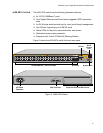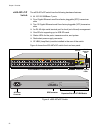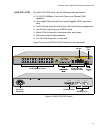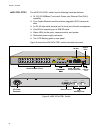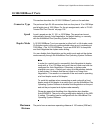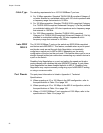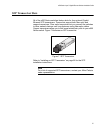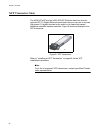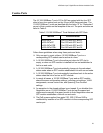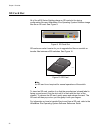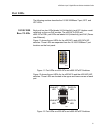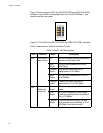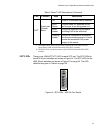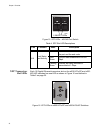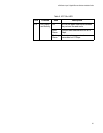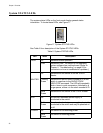
x600 Series Layer 3 Gigabit Ethernet Switches Installation Guide
29
Combo Ports
The 10/100/1000Base-T ports 21R to 24R are paired with the four SFP
slots to form four combo ports on the 24 port x600 Series switches. The
10/100/1000Base-T ports are identified with the letter “R” for “Redundant”
as part of their number on the faceplate of the unit. The ports and slots are
listed in Table 2.
Follow these guidelines when using these ports and slots:
Only one port in a pair, either a 10/100/1000Base-T port or a
corresponding SFP module can be active at a time.
A 10/100/1000Base-T port is the active port when its SFP slot is
empty, or when an SFP module is installed but has not established a
link to an end node.
A 10/100/1000Base-T port automatically changes to the redundant
status mode when an SFP module establishes a link with an end node.
A 10/100/1000Base-T port automatically transitions back to the active
status when the link is lost on an SFP module.
In nearly all cases, a 10/100/1000Base-T port and an SFP module
share the same configuration settings, including port settings, VLAN
assignments, access control lists, and Spanning Tree Protocol
settings.
An exception to the shared settings is port speed. If you disable Auto-
Negotiation on an 10/100/1000Base-T port and set the speed and
duplex mode manually, the speed reverts to Auto-Negotiation when an
SFP module establishes a link with an end node.
The PoE power supplied from ports 21R, 22R, 23R and 24R is
unaffected by insertion of an SFP module in to the corresponding SFP
combo port.
Table 2. 10/100/1000Base-T Ports Matched with SFP Slots
Models Ports and Slots
x600-24Ts
x600-24Ts/XP
x600-24Ts-POE
x600-24Ts-POE+
Port 21R with SFP slot 21
Port 22R with SFP slot 22
Port 23R with SFP slot 23
Port 24R with SFP slot 24



